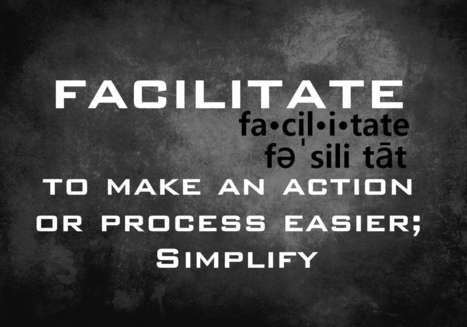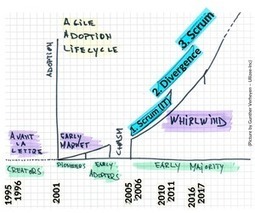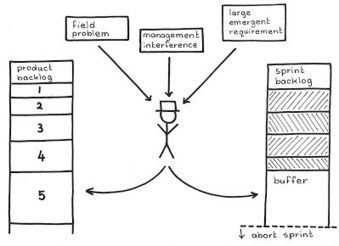 Your new post is loading...
 Your new post is loading...

|
Scooped by
Mickael Ruau
January 21, 2019 9:53 AM
|
Scrum Papers. Jeff Sutherland codified Scrum in 1995 with Ken Schwaber. Since then, he has continued to publish Scrum papers. More at http://scruminc.com/

|
Scooped by
Mickael Ruau
January 21, 2019 9:48 AM
|
This infographic is based on the book "Scrum: the art of doing twice the work in half the time" by Jeff Sutherland

|
Scooped by
Mickael Ruau
January 21, 2019 9:05 AM
|
Download your Certified Scrum Master course slides by clicking the link below. Bain_CSM_Joe_Avi

|
Scooped by
Mickael Ruau
January 21, 2019 2:05 AM
|
You notice that team members always postpone decisions and important work until one especially skilled Development Team member is present, but as the ScrumMaster you want all team members to perform optimally according to their abilities.

|
Scooped by
Mickael Ruau
January 19, 2019 4:17 AM
|
What Does a Facilitator Do?
To facilitate an event well, you must first understand the group's desired outcome, and the background and context of the meeting or event. The bulk of your responsibility is then to:
Design and plan the group process, and select the tools that best help the group progress towards that outcome.
Guide and control the group process to ensure that:
There is effective participation.
Participants achieve a mutual understanding.
Their contributions are considered and included in the ideas, solutions or decisions that emerge.
Participants take shared responsibility for the outcome.
Ensure that outcomes, actions and questions are properly recorded and actioned, and appropriately dealt with afterwards.
We look in more detail at most important of these areas below.

|
Scooped by
Mickael Ruau
January 18, 2019 2:41 PM
|
Méthodologie simple pour maximiser vos chances de réussite pour la certification Professional Scrum Master (PSM1) délivrée par Scrum.org

|
Scooped by
Mickael Ruau
January 18, 2019 2:37 PM
|
Like the other grooming activities, prioritization is best carried out by the entire Scrum team. This leverages the team’s collective knowledge and generates buy-in.
Prioritization directs the team’s work by focusing the team on the most important items. It also freezes the backlog contents progressively. As mentioned before, items are detailed according to their priority. This builds flexibility into the process and allows delaying decisions about the lower-priority items, buying the Scrum team more time to evaluate options, gather feedback from customers, and acquire more knowledge. This ultimately results in better decisions and a better product.
Since individual product backlog items can be very small and therefore difficult to prioritize, it’s useful to prioritize themes first. We then prioritize the items within and, if necessary, across themes. The remainder of this section explores the following factors in prioritizing
the product backlog: value; knowledge, uncertainty, and risk; releasability; and dependencies.

|
Scooped by
Mickael Ruau
January 18, 2019 2:30 PM
|
Daily Scrum
Agile Estimation in Practice
Prioritizing the Product Backlog
The Development Team
The Scrum Master
Sprint Execution
Empirical process control

|
Scooped by
Mickael Ruau
January 18, 2019 2:15 AM
|
Our Coaching Community of Practice meets weekly and the original question generated a lot of discussion and provided some great practical answers from personal experience in the role:
No interjection of one's own opinion or agenda
Let the participants determine the goal, don’t determine it for them
Beware of identifying with one specific person
Keep emotional distance
Think about deliverables and ask questions to facilitate that delivery [ex. the 3 questions of the Daily Stand Up]
Use active listening and questioning to guide the conversation and participants to find their own answers

|
Scooped by
Mickael Ruau
January 17, 2019 5:34 AM
|
Jim Coplien, co-author of Organizational Patterns of Agile Software Development, describes the Scrum Patterns movement, the origins of Scrum, and the research that will lead to a future book on Scrum Patterns.

|
Scooped by
Mickael Ruau
January 17, 2019 1:44 AM
|
A PDF of this text is available for download
The “ScrumAnd” poster (PNG) is available for download

|
Scooped by
Mickael Ruau
January 16, 2019 9:14 AM
|
Then there are enough questions outside the Scrum Guide. To answer this specific question, you need to know a technique that is not explained in the Scrum Guide. It is expected that you as a Scrum Master with some practical experience know certain “real-time techniques". We highly recommend you to use our PSM 1 practice tests
Also it is very important to remember:
Being concentrated on the exam during preparation is equally important as that of studying. The question arises here is how to do this? It depends on you. How to remain concentrated? Take the exam in your comfort duration (e.g., avoid selecting morning shift exam if you’re not an early riser) and move to a silent place to take the exam.
Be careful with the words: sometimes you don’t pay enough attention to some of the words, and answer the simplest of questions incorrectly. Always read the question carefully, word by word. Also make sure you’ve read all the answer before choosing the desired one.
Be careful with questions containing “NOT”: some questions ask, for example, “which of the following is NOT a characteristic of…”, and many people forget about the “NOT”, and pick the wrong answer. You won’t believe how common this is; so, be careful not to miss this keyword.
Be careful with multiple answer questions: some questions ask you to choose multiple answers, and some people just don’t pay enough attention and pick one answer. All multiple answer questions use check-boxes instead of radio-buttons; get used to paying attention to this as a double check. It’s a good idea to spend a few minutes at the end of the exam, going through all the questions and only checking to see if you’ve picked multiple answers where you needed.

|
Scooped by
Mickael Ruau
January 16, 2019 8:23 AM
|
In this presentation, we summarize the most important content of the Scrum Guide. The material can be used to share knowledge and have a common understanding a…
|

|
Scooped by
Mickael Ruau
January 21, 2019 9:52 AM
|
At the Lean IT Summit 2014, Jeff Sutherland described how Scrum derives from lean product development at Toyota and what was added to Lean to get software team…

|
Scooped by
Mickael Ruau
January 21, 2019 9:30 AM
|
An Impediment is anything that keeps the Team from getting work Done. If it's blocking the team from doing its work, it's an Impediment.

|
Scooped by
Mickael Ruau
January 21, 2019 3:17 AM
|
Scrum is a framework not only for producing product, but also for constantly advancing the abilities of the team producing that product. From a process perspective Scrum is all about improvement, which, in Japanese, is just “改善.” In its own process improvement effort Toyota took kaizen as a slogan, usually written as “カイゼン.” The international community picked up the term and started using it in the sense they projected from Toyota’s programs: continued, relentless improvement. The next pattern, ScrumMaster, describes the role that owns the Scrum process in a Scrum team and who often leads the charge for kaizen. However, it’s important to remember that kaizen is everyone’s job: the ScrumMaster is just the team’s kaizen conscience.

|
Scooped by
Mickael Ruau
January 20, 2019 4:03 AM
|
1.TIME MANAGEMENT
Problem: 1hour/80 questions = 45 sec – means no time to use the google/ Scrum Guide, what is more, questions are usually formulated in different ways so you can’t just google it.
Solution: Use A4 cheat sheet in front of you.
ex. HERE or HERE orr simply create your own SCRUM mind map using ( pen and paper ) :-))
silicon valley hbo
2.BOOKMARKS DURING EXAM
Long story short it’s a nightmare. Flow looks like that: You mark a question to add to the bookmarks, then there’s a list of bookmarked questions. Each of the questions you have to click, check correct answer then go back to the list view, scroll the page and look for next bookmarked questions. It consumes a massive amount of time. Be prepare for it.

|
Scooped by
Mickael Ruau
January 19, 2019 3:05 AM
|
Tips for passing Professional Scrum master (PSM1 )exam
Here are some tips that would make it easier for you to better understand Scrum and pass the PSM exam. Be ready to study and take multiple attempts of the online preparation tests. The exam is not easy until you practice a lot.
Read the Scrum Guide and refer back to it whenever a tricky question shatters your confidence of knowing Scrum. It is only 16 pages long and helps with clearing up your Scrum concepts.
Take the Open Assessments available at Scrum.org until you get 100% scores in all of the tests. Taking the Product Owner open assessment also prepares you to resolve complex questions that might come up during the exam.
Join and/or search for professional Scrum community forums to find good explanations to questions you might have. You can find very good Agile/Scrum discussions on Scrum.org.
Search the internet and take any other available free assessment exams for PSM preparation. Each practice exam will teach you a little more.
Take a paid Scrum Master training on mplaza.pm. It covers confusing and difficult questions very well and also gives great explanations on why answers are correct.
Must Read this free guide: Scrum Training Manual by Frank Turley and Nadar K. Rad. It captures some topics that are not in the Scrum Guide but can be part of the exam.
Retake all three mplaza exams to tighten your grip on all topics of exams.
Focus on Scrum Values and go through them separately. Maximizing Scrum is a good article to understand Scrum Values.
yodiz-Scrum-Values
Go through the Evidence-Based Management Guide to learn from practical examples.
Read the Nexus Guide to learn about Scaling Scrum. There might be a couple of related questions in the exam.
Learn about charts especially Burn-down charts, CFD and Cone of Uncertainty. There will be a few questions of interpreting these charts.
Repeat steps until all practice exams give you 100% results.
Note: Reading Thales Study and Nexus Guide is only to further enhance your knowledge of handling complex teams. Try to avoid reading Agile material that is not related to Scrum, as this will prevent you from extra confusion and complexities.

|
Scooped by
Mickael Ruau
January 18, 2019 2:39 PM
|
Agile estimation is often seen as being invaluable, yet others dismiss it as waste. The reasons for this disagreement can be traced to disparities in Scrum and Lean-Kanban ways of working, and to the fundamental differences between project work and Business As Usual. When seen in the context of Scrum projects, some form of estimation process is valuable.
Yet regardless of the method chosen, it must be acknowledged that a Scrum Team is responsible for its own estimates. No-one else can make a team's estimates for them. Going through that process of estimation, and understanding the size and scope of the work, is fundamental to the team's sense of Sprint Backlog ownership and to their commitment to a Sprint Goal.

|
Scooped by
Mickael Ruau
January 18, 2019 2:33 PM
|
If the Scrum Master does not attend the Daily Sprint, how would they know about impediments? Only the Development Team can participate in the Daily Scrum. However, the Scrum Master can choose to attend to ensure Scrum is correctly understood and enacted. They can also facilitate the Daily Scrum at the team’s request.
The question is – If the Scrum Master does not attend the Daily Sprint, how would they know come to know about impediments? This question assumes that impediments are brought out only during the Daily Scrum. That is incorrect. A team needs to bring out any impediment as soon as they know they need help.
So, the team will transparently make the impediments visible for anyone to see and also approach the Scrum Master when they know they need help.

|
Scooped by
Mickael Ruau
January 18, 2019 2:16 AM
|
Explicitly allot time for interrupts and do not allow more work than fits within the allotment. If work exceeds the allotment, abort the Sprint.
Set up three simple rules that will cause the company to self-organize to avoid disrupting production.
This strategy will help the team re-plan during the Sprint to raise the chances of delivering the complete Product Increment.
The team creates a buffer for unexpected items based on historical data. For example, let’s say that a third of the team’s work on the average comes from unplanned work coming into the Sprint unexpectedly. If the team velocity averages 60 points, the team reserves 20 points for the interrupt buffer.
All non-trivial requests must go through the Product Owner for triage. (Web page spelling errors and compilation errors are examples of trivial errors where the fix is so obvious that there is no benefit from additional business insight. Developers may spend some small, time-boxed amount of time addressing even non-trivial defects before escalating to the Product Owner.) The Product Owner will give some items low priority if there is no perceived value relative to the business plan. The Product Owner will push many other items to subsequent Sprints even if they have immediate value. A few items are critical and the team must complete them in the current Sprint, so the Product Owner puts them into the interrupt buffer.
If the buffer starts to overflow, that is, the Product Owner puts one point more than 20 points into the Sprint, the Scrum Team must automatically abort, the Sprint must be re-planned, and the Product Owner notifies management that dates will slip.
It is essential to get management agreement on these rules and to enforce them. The Product Owner must always be available to the team and other stakeholders. In the Product Owner’s absence, the Scrum Team should designate one of its own to temporarily fill that role.

|
Scooped by
Mickael Ruau
January 17, 2019 9:15 AM
|
According to the Scrum Guide, The Scrum Master serves the Product Owner in several ways, including:
• Ensuring that goals, scope, and product domain are understood by everyone on the Scrum Team as well as possible;
• Finding techniques for effective Product Backlog management;
• Helping the Scrum Team understand the need for clear and concise Product Backlog items;
• Understanding product planning in an empirical environment;
• Ensuring the Product Owner knows how to arrange the Product Backlog to maximize value;
• Understanding and practicing agility; and,
• Facilitating Scrum events as requested or needed.
• Scrum Master Service to the Development Team
The Scrum Master serves the Development Team in several ways, including:
• Coaching the Development Team in self-organization and cross-functionality;
• Helping the Development Team to create high-value products;
• Removing impediments to the Development Team’s progress;
• Facilitating Scrum events as requested or needed; and,
• Coaching the Development Team in organizational environments in which Scrum is not yet fully adopted and understood.
Scrum Master Service to the Organization
• The Scrum Master serves the organization in several ways, including:
• Leading and coaching the organization in its Scrum adoption;
• Planning Scrum implementations within the organization;
• Helping employees and stakeholders understand and enact Scrum and empirical product development;
• Causing change that increases the productivity of the Scrum Team; and,
• Working with other Scrum Masters to increase the effectiveness of the application of Scrum in the organization.

|
Scooped by
Mickael Ruau
January 17, 2019 2:17 AM
|
Only a small minority of Scrum teams make the paradigm shift to a radical new level of performance and ability to create value This is because most teams fail to identify and remove impediments. Their work is not Done (see Definition of Done), their backlog is not Ready (see Definition of Ready), and the team does not self-organize to improve performance.
Difficult impediments may require extremely focused efforts to remove. Working on many impediments at once often leads to a lot of work with little gain and can demoralize the team.

|
Scooped by
Mickael Ruau
January 16, 2019 9:58 AM
|
Scrum does not require team members be co-located. However, co-location is quite helpful for fostering collaboration. If team members are located in the same building but still sitting in separate individual spaces, create a team space for them.
A team space should be a comfortable area where it is easy for team members to work together. Throwing a team in a cramped conference room without any windows does not create an environment for collaboration. A team space should respect that individuals needs space for their belongings and to do their work. The space should have lots of wall space - even if not permanent - for the team to keep visible information. Also have plenty of white board space. Magnetic white board walls are amazing!
A Scrum Board helps a team plan their work together and stay focused on the Sprint goal. If progress is visualized, it fosters collaborative planning. It helps enable discussions about how to get something to done and what is the most important thing to focus on next.
Sometimes team members need to have a private conversation or a place to quietly think. Ideally, also have a private space that the team can use without having to "reserve" it.
If the team cannot be co-located, take advantage of the many collaboration tools available. Face-to-face communication is best. Consider Google Hangout (or a similar tool) for team events, refinement sessions, and pairing. You can even keep a Google Hangout open all day for remote team members to connect via video and work all day.
If you have remote team members, try to bring the team together in one location periodically. This is especially helpful when starting up a new team, implementing significant process improvements, or moving the product in a new direction.

|
Scooped by
Mickael Ruau
January 16, 2019 8:52 AM
|
Préparer la certification
- Lire la dernière version du Scrum Guide en anglais. Il ne doit y avoir aucune zone d'ombre. Décortiquer chaque mot, chaque phrase et bien faire attention aux verbes utilisés. Lire le Scrum Guide à plusieurs reprises, cela tant que vous découvrez des nouvelles informations en le relisant.
- Lire le Scrum Guide en français est utile pour vérifier que l'interprétation des traducteurs correspond aussi à votre interprétation.
- Lire le glossaire https://www.scrum.org/resources/scrum-glossary
- Lire le glossaire https://mplaza.pm/scrum-glossary/
- Il peut y avoir des questions sur le burndown chart, lire les pages wikipedia et Webgate
- Passer le test blanc "Scrum Open" sur https://www.scrum.org/open-assessments Les questions sont bien plus faciles que celles de la certification. Passer le test jusqu'à le réussir à 100% plusieurs fois d'affilé, et ce sans aucune hésitation ! Certaines des questions du test blanc se retrouveront dans le test officiel. Ne pas se contenter de trouver la bonne réponse, mais aussi comprendre pourquoi les autres réponses ne sont pas bonnes.
- Dans le forum de scrum.org, rechercher les discussions sur les sujets où vous avez un doute.
- Lire les conseils Ainsi pense la scrum.org (Pense pas Bête pour comprendre les assesments de niveau 1)
- Lire "The Scrum Master training Manual" (gratuit)
- Faire des tests blancs supplémentaires destinés à la certification PSM I : http://mlapshin.com/index.php/scrum-quizzes/ ou encore https://www.thescrummaster.co.uk/professional-scrum-master-i-psm-i-practice-assessment/ (attention aux tests que l'on peut trouver sur Internet, dont la plupart comportent de nombreuses réponses considérées comme fausses par scrum.org)
- Des réponses à des questions sur Scrum : http://mlapshin.com/index.php/blog/scrum-questions/
- Lire le Nexus Guide pour répondre aux questions sur l'agilité à l'échelle.
- Passer les tests blancs de Product Owner (PSPO) et Nexus (SPS)
- Lire Evidence-Based Management Guide
Si vous avez du temps :
- Lire l'article The New New Product Owner
- Suggestions de lecture pour le Scrum Master de Scrum.org
- Lire Scrum Insights for Practitioners: The Scrum Guide Companion
|
 Your new post is loading...
Your new post is loading...
 Your new post is loading...
Your new post is loading...





















